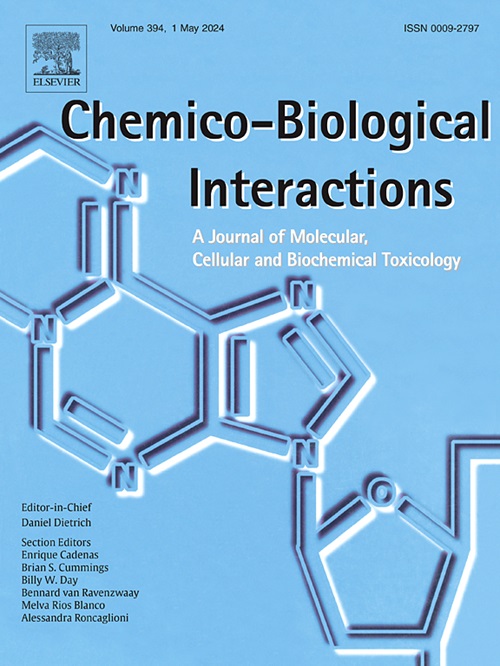轮胎磨损颗粒的车辆特定毒理学特征:由轻型和重型车辆排放引起的斑马鱼生理、微生物和转录组紊乱
IF 4.7
2区 医学
Q1 BIOCHEMISTRY & MOLECULAR BIOLOGY
引用次数: 0
摘要
来自车辆的轮胎磨损颗粒(twp)已成为环境微塑料的重要来源,向水生生态系统释放有害金属和有机污染物。然而,来自重型车辆轮胎磨损颗粒(HTWPs)和轻型车辆轮胎磨损颗粒(LTWPs)的TWPs的不同毒理学效应仍然没有得到充分的表征。在这里,我们全面评估了暴露于HTWPs和LTWPs的斑马鱼的生理反应、肠道微生物群改变和肝脏转录组学变化。扫描电子显微镜(SEM)分析显示,与ltwp相比,htwp具有更粗糙的表面和更锋利的边缘。在生理上,高温高压暴露导致身体和器官生长指标显著降低,并诱导持续的氧化应激反应,而低温高压则引发相对温和的氧化效应。微生物分析表明,高温高压暴露后肠道生态失调显著,其特征是微生物多样性下降,致病性不动杆菌丰度增加,与肝脏irf1b表达负相关。基于PICRUSt2的功能预测进一步揭示了肠道微生物代谢的特异性改变:HTWP暴露下免疫和外源相关途径丰富,而LTWP暴露增强了与脂质代谢相关的微生物功能。这些功能变化提示潜在的宿主-微生物代谢串扰。转录组学分析表明颗粒型特异性破坏:HTWPs主要损害碳水化合物代谢,下调关键糖酵解基因(pgk1, pkma),而LTWPs主要改变脂质代谢途径,如acacb减少和hahaa表达增加所证明的。值得注意的是,HTWP和LTWP暴露都通过MAPK途径激活炎症信号,特别是通过上调mapk8a。定量PCR验证证实了RNA-seq结果的稳健性和可靠性。总之,这些发现强调了由车辆源驱动的不同毒理学机制,并强调了对特定源的生态风险评估的必要性,以减轻TWP污染的环境影响。本文章由计算机程序翻译,如有差异,请以英文原文为准。
Vehicle-specific toxicological profiles of tire wear particles: Physiological, microbial, and transcriptomic disruptions in zebrafish induced by light and heavy-duty vehicle emissions
Tire wear particles (TWPs) from vehicles have emerged as significant sources of environmental microplastics, releasing hazardous metals and organic contaminants into aquatic ecosystems. However, the differential toxicological effects of TWPs originating from heavy-duty vehicle tire wear particles (HTWPs) versus light-duty vehicle tire wear particles (LTWPs) remain inadequately characterized. Here, we comprehensively evaluated physiological responses, gut microbiota alterations, and liver transcriptomic changes in zebrafish exposed to HTWPs and LTWPs. Scanning electron microscopy (SEM) analysis revealed that HTWPs exhibit rougher surfaces and sharper edges compared to LTWPs. Physiologically, HTWP exposure resulted in marked reductions in body and organ growth metrics and induced sustained oxidative stress responses, whereas LTWPs triggered comparatively milder oxidative effects. Microbial analysis demonstrated significant gut dysbiosis following HTWP exposure, characterized by decreased microbial diversity and an increased abundance of pathogenic Acinetobacter, negatively correlated with hepatic irf1b expression. Functional predictions based on PICRUSt2 further revealed vehicle-specific alterations in gut microbial metabolism: immune- and xenobiotic-related pathways were enriched under HTWP exposure, while LTWP exposure enhanced microbial functions related to lipid metabolism. These functional shifts suggest potential host-microbiota metabolic crosstalk. Transcriptomic analyses indicated particle-type-specific disruptions: HTWPs predominantly impaired carbohydrate metabolism, downregulating critical glycolytic genes (pgk1, pkma), while LTWPs primarily altered lipid metabolic pathways, as evidenced by decreased acacb and increased hadhaa expression. Notably, both HTWP and LTWP exposures activated inflammatory signaling via the MAPK pathway, particularly through upregulation of mapk8a. Quantitative PCR validation confirmed the robustness and reliability of the RNA-seq results. Together, these findings highlight distinct toxicological mechanisms driven by vehicle source and underscore the need for source-specific ecological risk assessments to mitigate the environmental impact of TWP pollution.
求助全文
通过发布文献求助,成功后即可免费获取论文全文。
去求助
来源期刊
CiteScore
7.70
自引率
3.90%
发文量
410
审稿时长
36 days
期刊介绍:
Chemico-Biological Interactions publishes research reports and review articles that examine the molecular, cellular, and/or biochemical basis of toxicologically relevant outcomes. Special emphasis is placed on toxicological mechanisms associated with interactions between chemicals and biological systems. Outcomes may include all traditional endpoints caused by synthetic or naturally occurring chemicals, both in vivo and in vitro. Endpoints of interest include, but are not limited to carcinogenesis, mutagenesis, respiratory toxicology, neurotoxicology, reproductive and developmental toxicology, and immunotoxicology.

 求助内容:
求助内容: 应助结果提醒方式:
应助结果提醒方式:


